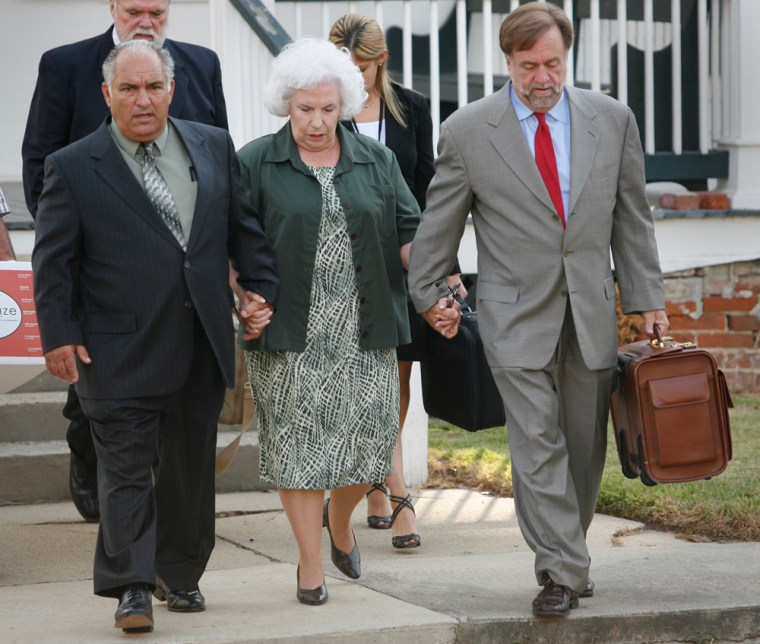Jurors hearing the homicide case against a couple who own a nursing home where 35 people died after Hurricane Katrina saw photos Thursday of bodies lying in muck and storm-tossed debris.
The pictures were shown over the objection of lawyers for Salvador and Mabel Mangano, owners of St. Rita’s nursing home, which the storm swamped as it wiped out St. Bernard Parish on Aug. 29, 2005.
It was the first day of testimony in the trial of the Manganos, who face 35 counts of negligent homicide and 24 counts of cruelty for the death and suffering of St. Rita’s residents. The six jurors and three alternates showed little emotion as they examined the photos, which were identified by the first witness, parish Deputy Erroll Schults.
A prosecutor told the panel in opening arguments Thursday that it was bad judgment by the Manganos in not evacuating the nursing home that cost 35 lives, not faulty storm planning by the government.
Prosecutor Paul Knight tried to head off the couple’s contention that mistakes by state and federal agencies led to the deaths nearly two years ago. Prosecutors do not believe the Manganos intentionally killed their residents — he called the couple “good people” — but they were the cause nonetheless, Knight said.
“We would never stand here and tell you that the federal government was perfect, that the state government was perfect, that local government was perfect. But despite that, the only reason these people are dead is because of decisions by the Manganos,” Knight said.
Spectators weep at charges
Defense attorney John Reed countered that the Manganos are scapegoats for a government that failed on many levels, including a failure to warn them they should evacuate their patients. Prosecuting the Manganos only makes matters worse, he said.
“This government that served us so badly,” he said, pointing to prosecutors, “would now turn on its people.”
The Manganos are charged with 35 counts of negligent homicide and 24 counts of cruelty to the elderly or infirm. Prosecutors are expected to outline a scenario in which the Manganos ignored urgent warnings to evacuate, which, the state contends, led directly to the deaths and the suffering of the nursing home residents who survived.
The combined maximum sentence for each defendant would be 415 years in prison.
The trial opened nearly two years after Katrina swamped the Mississippi and southeastern Louisiana coasts on Aug. 29, 2005. The storm flooded 80 percent of New Orleans and all but wiped out nearby St. Bernard Parish, where St. Rita’s flooded almost to the ceiling. More than 1,400 deaths were blamed on the storm.
The trial was moved to St. Francisville, about 100 miles northwest of St. Bernard, because the parish’s population is still diminished because of the storm. Supporters of the Manganos, as well as relatives of some of the victims, were in the courtroom Thursday. As the charges were read by a court clerk, with each victim’s name read aloud, some spectators wept softly.
'People die in evacuations'
Reed argued that St. Rita’s was considered one of the safest areas in St. Bernard, so safe that the Manganos and more than 30 of their friends and relatives rode out Katrina in the building. The strength of their building and the frailty of the residents played into their decision to stay, he said.
“The decision to stay or go is one of the most serious you can make because people die in evacuations,” Reed said. “The old and the frail die during evacuations and after them. And if you love those people it’s an awesome responsibility.”
Mangano family members acted quickly after a wall of water engulfed the area as Katrina’s winds died down, Reed said, adding that relatives waded through deep, fast waters, retrieved two boats and began helping with rescues. Mabel Mangano, who is 5-foot-1 and does not swim, at one point stood on a planter in the nursing home, balancing on it as she held a patient’s head above water, said another defense lawyer, Robert Habans.
Reed acknowledged that an evacuation might have harmed or killed relatively few residents but said it is easy to second-guess the decision after the storm.
The defense has subpoenaed Gov. Kathleen Blanco to testify about Louisiana’s emergency plans. On Thursday, a state appeals court refused her request to dismiss a judge’s order that she testify.
The same appeals court blocked a judge’s order allowing prosecutors to call meteorologists from three TV stations to testify about what their stations aired in the three days before Katrina hit, a lawyer for the stations said Thursday.
'A huge step'
Also Thursday, a judge agreed to erase the public criminal record of a doctor arrested but never charged in the deaths of patients at a sweltering, flooded New Orleans hospital following the hurricane. The judge also said authorities must keep secret all materials put before the grand jury that last month declined to indict Dr. Anna Pou.
Pou called Johnson’s decision “a huge step in helping me get by life back together.”
